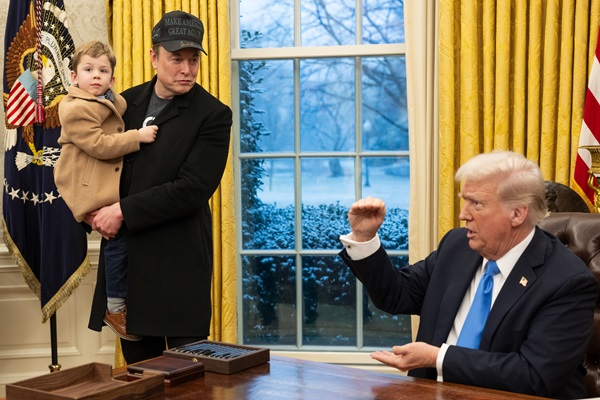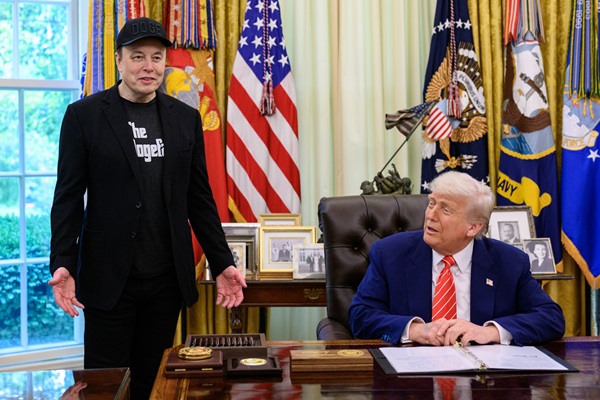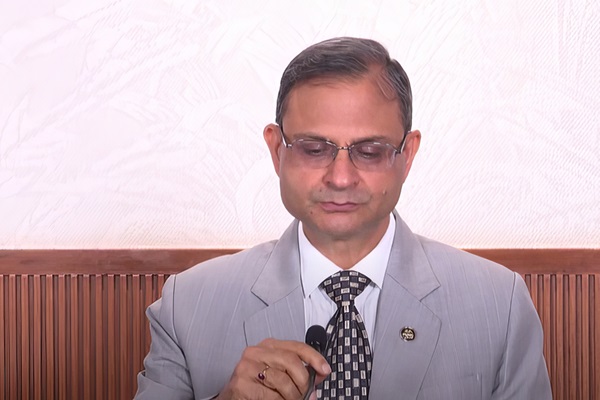.png)
The Morning Edge: US Pushes Back on Tariff Concerns, Eyes Xi-Trump Call on Minerals
A newsletter designed to prepare you for the day, offering a concise summary of overnight developments and key events ahead that could influence your workday.

By Richard Fargose
June 2, 2025 at 1:29 AM IST
QUICK SNAPSHOT
Global Sentiment: Risk-off
Factors: US-China trade deal
TODAY’S WATCHLIST
- India May S&P Manufacturing PMI
- US May S&P Manufacturing PMI
- US Fed Powell speaks
THE BIG STORY
As the United States navigates intricate trade disputes on multiple fronts, senior administration officials remain confident despite the uncertainty clouding the path ahead. In separate interviews over the weekend, Commerce Secretary Howard Lutnick and Treasury Secretary Bessent sought to reassure markets and allies that the Trump administration remains firmly in control of negotiations, despite growing legal questions.
Lutnick brushed aside concerns that the legal ambiguity surrounding US tariffs might hand the European Union leverage in ongoing negotiations, dismissing critics as “silly people making silly comments.” He underscored the Trump administration’s resolve to protect American workers and push for favourable terms in talks with Europe.
Meanwhile, Treasury Secretary Bessent addressed rising tensions with China, expressing optimism that President Trump and Chinese
President Xi Jinping will speak soon to defuse the latest flare-up—this time over critical minerals vital to global supply chains. Accusing Beijing of backtracking on a key agreement to lift restrictions, Bessent struck a firm but hopeful tone: “Maybe it’s a glitch, maybe it’s intentional. We’ll see after the President speaks with the Party Chairman.”
Taken together, the comments reflect a White House determined to project strength and stability in an increasingly fractious global trade landscape, even as questions persist over the long-term impact of its hardball tactics.
DATA
US consumer spending rose just 0.2% in April, as households pulled back amid rising economic uncertainty and a shifting tariff landscape. The modest gain followed a 0.7% jump in March, according to the Commerce Department. Meanwhile, the US goods trade deficit narrowed sharply by 46% to $87.6 billion in April, as front running of imports to beat tariffs faded. Imports fell by $68.4 billion to $276.1 billion, while exports rose by $6.3 billion to $188.5 billion. This narrowing goods trade gap could help lift GDP in the second quarter, after trade subtracted a record 4.9% from growth in March quarter. The data suggests the economy remains under pressure, but trade could offer a partial offset in the near term.
WHAT HAPPENED OVERNIGHT
US stocks ended mixed after a volatile session on Friday. The Nasdaq posted its largest monthly percentage gain since November 2023. Markets opened lower after President Trump accused China of breaching a trade deal and threatened new actions. However, his later upbeat comments on a potential deal helped ease selling pressure on Friday. For May, the S&P 500 rose 4.8%, the Nasdaq surged 6.1%, and the Dow climbed 2.7%. Ulta Beauty soared 11.8% after the cosmetics retailer raised its annual profit forecast following strong quarterly results.
US Treasury snapped a four-week losing streak, with the long end outperforming. The benchmark 10-year yield ended Friday at a three-week closing low of 4.40%, supported by data showing US PCE inflation cooled to 2.1% in April, effectively in line with the Fed’s 2% target. Despite this, the 10-year yield rose 0.245 basis points in May to 4.418%, while the two-year yield posted its largest monthly gain since October, rising 0.295 to 3.914%.
The US dollar as mixed on Friday but headed for its first monthly gain against the Japanese yen this year, as investors factored in the likelihood of trade tariffs remaining in some form, even as US President Donald Trump faces a court battle over his authority to impose them. The euro was down 0.12% at $1.1356, 0.27% monthly gain, its smallest since February. The dollar weakened 0.21% to 143.88 yen.
Brent crude oil prices fell 0.4% to settle at $63.90 per barrel on Friday, capping a weekly loss of over 1% as trade tensions and supply concerns weighed on prices. President Trump reignited fears by accusing China of violating a recent tariff truce, fuelling uncertainty ahead of the weekend’s OPEC+ meeting. On Saturday, OPEC+ confirmed it will proceed with a 411,000 barrels per day output increase for July, as the group looks to regain market share and discipline over-producers. After years of curbing production by more than 5 million barrels per day or 5% of global demand, OPEC+ had made a modest output increase in April before tripling it for May, June, and now July.
Day’s Ledger
Economic Data
- India May S&P Manufacturing PMI
- US May S&P Manufacturing PMI
- US April Construction Spending data
Corporate Actions
- Mercator Ltd board to consider earnings for March quarter
Policy Events
- US Fed Chair Powell speaks
- German Buba Balz speaks
TICKERS
- APOLLO HOSPITALS posted a 59.3% year-on-year increase in January–March quarter net profit to ₹4.12 billion, exceeding estimates. Revenue grew 13.1% to ₹55.92 billion, EBITDA rose 20.2% to ₹7.70 billion, and the margin improved to 13.76%.
ASTRAZENECA PHARMA reported a 47.7% year-on-year increase in January–March quarter net profit to ₹0.58 billion, driven by strong revenue growth and significant operating margin expansion. - CIPLA confirmed that the US Food and Drug Administration concluded a current good manufacturing practice inspection of its Bommasandra facility between 26–30 May 2025, issuing one observation. The company pledged timely compliance with a detailed response.
- COAL INDIA filed a draft red herring prospectus for its subsidiary Bharat Coking Coal with the Securities and Exchange Board of India, the National Stock Exchange, and the Bombay Stock Exchange, proposing an initial public offering involving an offer-for-sale of up to 465.7 million shares.
- GENUS POWER recorded a fivefold rise in January–March quarter net profit to ₹1.23 billion. Revenue more than doubled to ₹9.37 billion, EBITDA surged to ₹1.96 billion, and margins expanded to 20.95%.
- INDIGO gets a final three-month extension from the Directorate General of Civil Aviation for the wet lease of two Turkish Airlines Boeing 777 aircraft, originally approved for six months and set to expire on May 31.
- INOX WIND reported a January–March quarter net profit of ₹1.90 billion, up from ₹0.39 billion a year earlier. Revenue more than doubled to ₹13.11 billion, while full-year 2024–25 profit stood at ₹4.38 billion, marking a turnaround from a ₹0.48 billion loss.
- IRB INFRASTRUCTURE announced that its associate, IRB Infrastructure Trust, will transfer three BOT highway assets to the IRB InvIT Fund for an enterprise value of ₹84.50 billion and equity value of ₹49.05 billion, covering 1,800 lane kilometres.
- NYKAA saw net profit jump to ₹0.20 billion in the January–March quarter from ₹0.07 billion a year earlier. Revenue rose 23.6% to ₹20.62 billion, while EBITDA increased 43% to ₹1.33 billion, with margins improving to 6.47%.
- PURAVANKARA posted a widened loss of ₹0.88 billion in the January–March quarter, up from ₹0.067 billion a year earlier, as revenue plunged 41% to ₹5.42 billion from ₹9.20 billion.
- SENCO GOLD reported a 94 % jump in consolidated net profit to ₹624.4 million for the March quarter.
- SPANDANA SPHOORTY Financial reported a January–March quarter net loss of ₹4.34 billion, compared to a profit of ₹1.29 billion in the same period last year. Revenue declined 38% year-on-year to ₹4.15 billion from ₹6.69 billion.
- SUN TV NETWORK posted a 10.4% year-on-year decline in January–March quarter net profit to ₹3.72 billion. Revenue dipped 2.2% to ₹9.41 billion, EBITDA dropped 18% to ₹4.29 billion, and margins narrowed to 45.61%.
- VODAFONE IDEA reported a narrowed January–March quarter loss of ₹71.66 billion and received board approval to raise up to ₹200 billion, subject to shareholder and regulatory clearance.
MUST READ
- India’s buying more oil from US, not any less from Russia
- India expected to raise agriculture and fisheries concerns at informal WTO ministers’ meet
- GST collections jump 16.4% yoy to ₹2.01 trillion in May
- Trump, Xi likely to speak soon on minerals trade dispute
- Rubio says lack of social-media profile could prompt visa denial
- India toughens stance in US trade talks after courts weigh in
- IndiGo expands network with Air France-KLM, Virgin Atlantic, Delta deal
- IKEA to amplify sourcing from India to 50% for its global operations
- We've leased every aircraft available globally; nothing left: Air India CEO
- Cane variety with 14% sugar recovery rate can boost Maharashtra's economy: Gadkari
- Ukraine hits over 40 Russian warplanes in major drone attack







